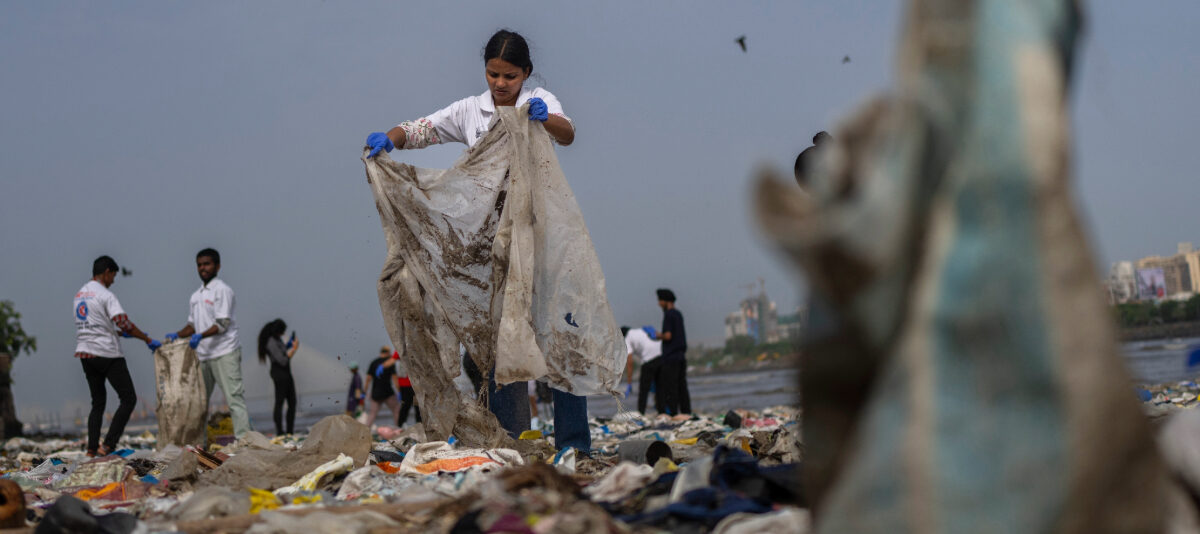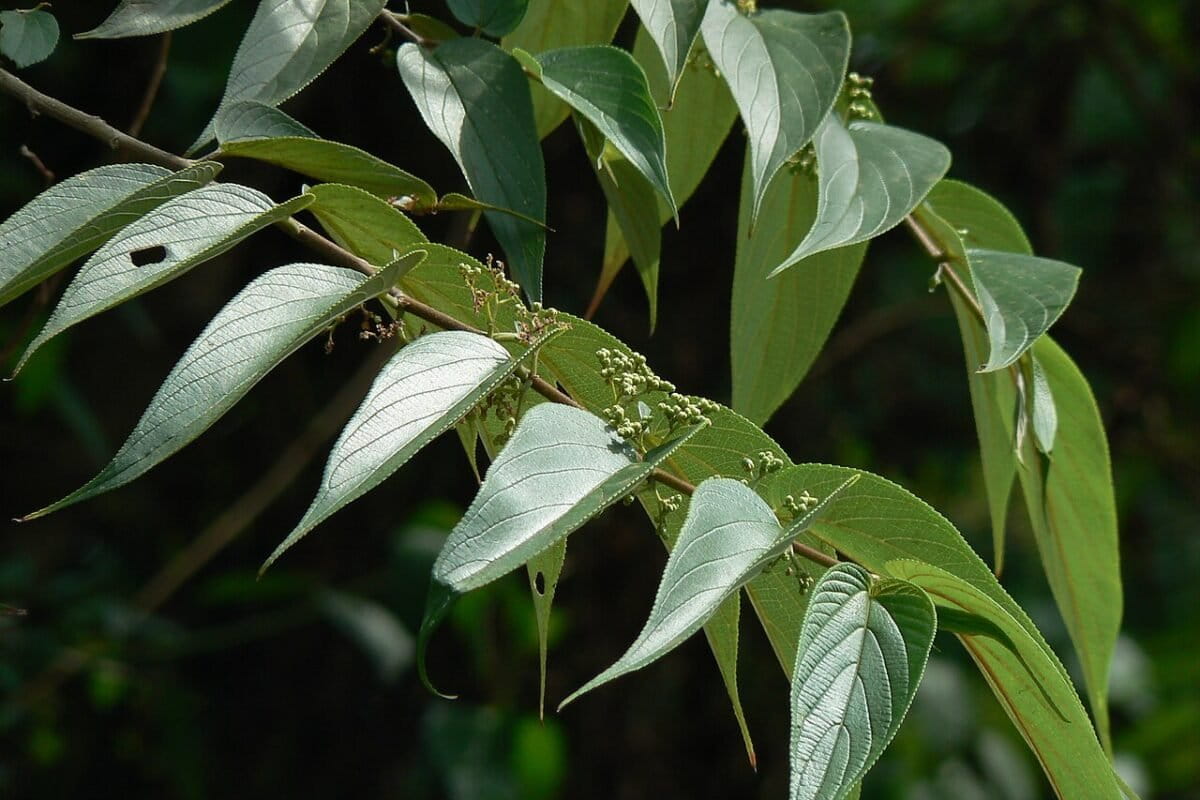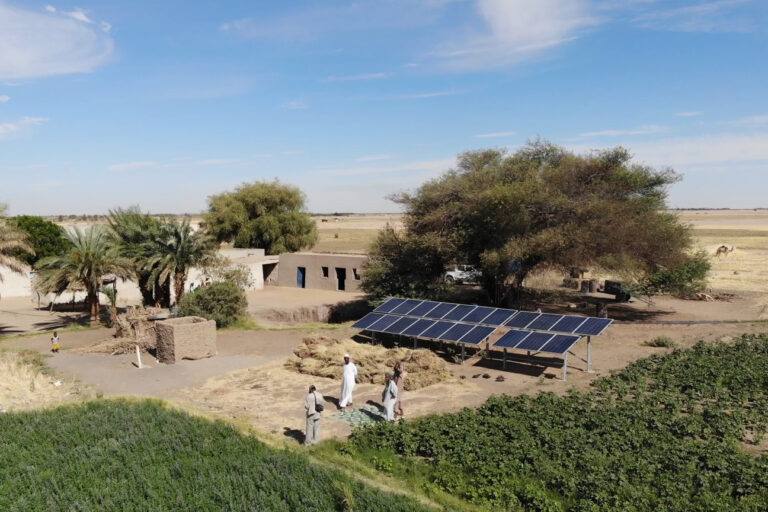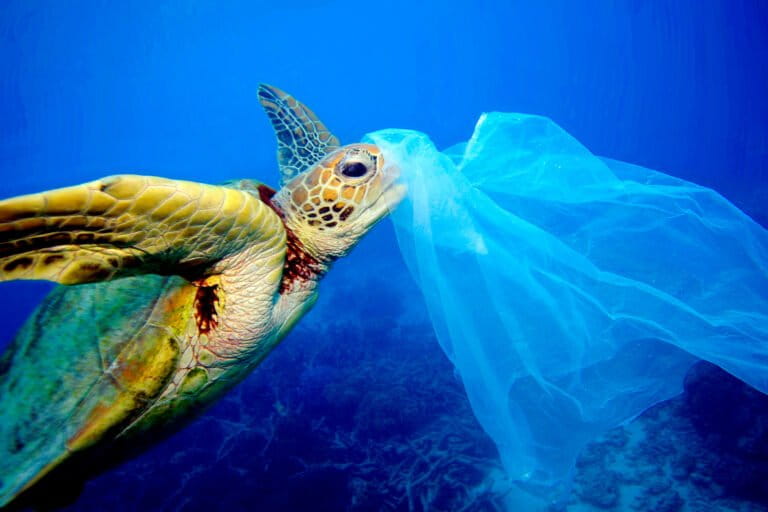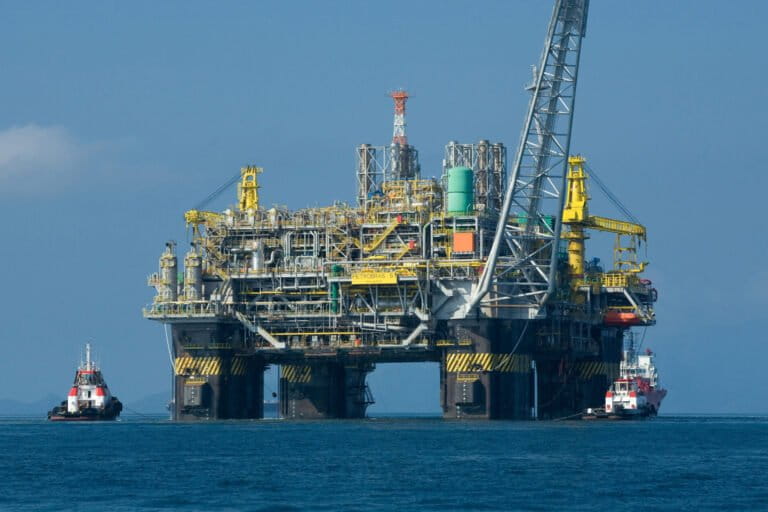This year has been full of bad news regarding marine ecosystems: one-third of coral species threatened with extinction, dead-zones spread to 415 sites, half of U.S. reefs in fair or bad condition, increase in ocean acidification, tuna and shark populations collapsing, and only four percent of ocean considered pristine. Jeremy Jackson, director of the Scripps Center for Marine Biodiversity and Conservation at the University of California, San Diego, synthesizes such reports and others into a new paper, published in the journal Proceedings of the National Academy of Sciences, that boldly lays out the scope of the oceanic emergency and what urgently needs to be done.
“The purpose of… the paper is to make clear just how dire the situation is and how rapidly things are getting worse,” said Jackson. “It’s a lot like the issue of climate change that we had ignored for so long. If anything, the situation in the oceans could be worse because we are so close to the precipice in many ways”.
For millennia the seas seemed an endless resource: unimaginably large and deep, brimming with life. How could such a seemingly inexhaustible recourse ever dwindle or even disappear? Increasingly, studies are showing catastrophic declines not only in fish favored for consumption, but in sea life altogether. A perfect storm of over-exploitation, nutrient pollution, and climate change is creating an uncertain future for the planet’s ocean, according to Jackson.
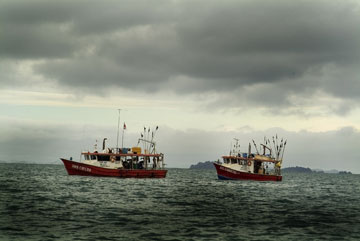 Simply enforcing fisheries regulations would go a long way to preventing species extinctions. Credit: Marcos Guerra, STRI |
Jackson admits that his study contains difficulties. “The problems are complex because of the huge numbers of species and different kinds of perturbations involved, the nonlinear dynamics of interactions among them, and the infancy of the emerging theoretical framework required to interpret the results”. However, Jackson says that one overall theme is clear: “all of the different kinds of data and methods of analysis point in the same direction of drastic and increasingly rapid degradation of marine ecosystems”.
An empty ocean: the impact of over-exploitation
The U.S. is the world’s third largest consumer of seafood after Japan and China. In 2007 the U.S. ate almost 5 billion pounds of seafood alone, 85 percent of which was imported. The 5 billion pounds does not include the amount of by-catch—target fish that is too small, non-target fish, sharks, dolphins, marine turtles, seals—that is caught and discarded.
According to Jackson’s paper, stocks of predatory fish — including tuna, salmon, cod, swordfish, and rays — have been diminished by 90 percent since the 1950s. In the Northern Atlantic popular dinner items such as cod, pollack, and haddock—all predatory fish—have dropped by 89 percent in a century, leading to a deep decline of the fishing industry in this region. Yet still such species are fished. Both northern and southern bluefin tuna are considered critically endangered, yet are heavily caught. The decline of sharks has occurred even faster, a study in the Northwest Atlantic showed that population declined 40 to 89 percent in just fourteen years. Sharks are caught both for consumption and as bycatch.
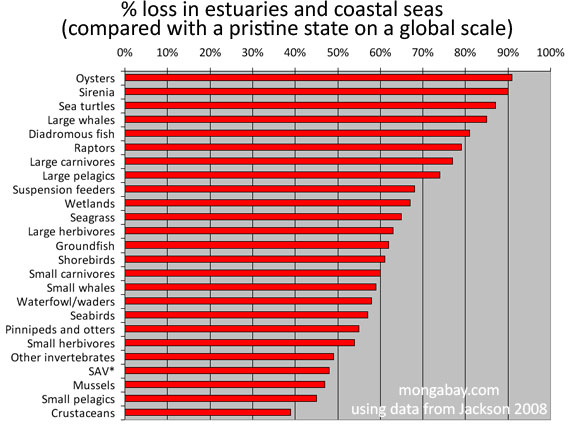
Percent decline (biomass, catch, percent cover) for fauna and flora from various marine environments. Chart based on data from Jackson 2008. |
This widespread decline of marine predators has lead to what is called a trophic cascade, wherein the loss of top predators causes population changes down through the food chain. The example Jackson presents is the loss of sharks in the Northwest Atlantic. This led to a rapid rise of the cownose ray, which number now at about 40 million. The ray feeds on oysters and clams and its population explosion has resulted in the collapse of clam fisheries. A trophic cascade can run all the way down a food chain, leading to drops in zooplankton and rises in phytoplankton, changing the ecosystem entirely.
It’s not just predatory fish that are targeted by fisheries around the world. Jackson writes that “oysters were the first invertebrates to suffer extreme depletion”. He adds that “the massive destruction of oyster reefs by dredging has permanently destroyed much of the formerly great habitat complexity of estuaries and coastal seas worldwide”. Oysters have suffered a global loss of 91 percent. The oyster population has been unable to recover due to the habitat loss, nutrient pollution, and disease, Jackson notes.
Animals that are common bycatch for fisheries have suffered almost as much—in some cases more—than the target fish. Of the seven marine turtle species all are considered endangered to some degree (except the flatback turtle which lacks the necessary data). Three of the seven are critically endangered. Green turtles have plummeted from historical numbers of 90 million to approximately 300,000 today, a drop over 99 percent. The leatherback turtle has declined by two-thirds since 1980 in the most optimistic scenario.
Out of a total 80 marine species examined, Jackson notes that 91 percent are depleted, 31 percent have become rare, and 7 percent have gone extinct. He writes “nowhere are there any substantial signs of recovery, despite belated conservation efforts, except for nominal increases in some highly protected birds and mammals”.

Percent decline (biomass, catch, percent cover) for fauna and flora from various marine environments. Chart based on data from Jackson 2008. |
A gasping ecosystem: when nutrients become pollutants
In the last fifty years dead-zones have caused massive shifts in coastal ecosystems. According to one recent study, dead zones have doubled every decade since 1960, reaching a record number at 415 by 2008.
Dead zones are caused by an influx of nutrients. Nitrogen-based fertilizer, sewage, domesticated animal manure, and industrial runoff enters a coastal environment causing eutrophication, or an increase in chemical nutrients. This surfeit of nutrients leads to massive algal blooms, which eventually die and are broken down by bacteria. The process uses the regions oxygen leading to hypoxia, essentially starving the area of oxygen.
Dead zone are usually seasonal, occurring every summer. But some sites have begun to show long-term dead zones. These zones are not literally devoid of life渴rather they have undergone massive population changes. Dead zones support “an extraordinary biomass of diverse microbes and jellyfish that may constitute the only surviving commercial fishery,” Jackson writes, but little else survives in a dead zone. As such dead zones have had large effects on fish-yields and biodiversity.
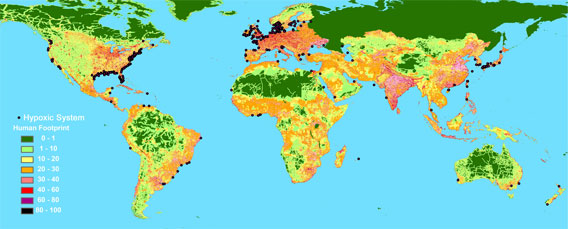 Global distribution of the 400+ marine systems with dead zones caused by increased eutrophication. Their distribution matches the current human “footprint” in the northern hemisphere. In the southern hemisphere, dead zones have only been reported recently. [Image courtesy of Science/AAAS] |
As an example, Jackson writes that “the iconic American example is the hypoxic ‘dead zone’ that extends some 500 km west of the Mississippi delta. The area of the hypoxic zone has doubled in the past 20 years to 20,000 km2.” Runoff into the Mississippi, especially nitrogen fertilizer, is the cause of this massive dead zone. This is not the way it used to be: “analyses of the geochemistry and mineralogy of cores shows that hypoxic conditions were uncommon before the 1950s,” writes Jackson.
‘Uncontrolled experiments’ in play
The effects of climate change on the ocean are an “uncontrolled experiment” according to Jackson. Seas are absorbing ever greater amounts of carbon dioxide from the atmosphere, leading to ocean acidification, which combined with climbing temperatures, is having a profound effect on coral reefs , the ocean’s most biodiverse ecosystem:.
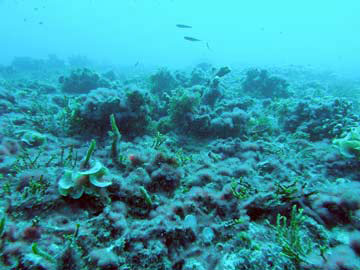 During a recent research expedition to Kiritimati, or Christmas Island, Jeremy Jackson and other researchers documented a coral reef overtaken by algae, featuring murky waters and few fish. The researchers say pollution, overfishing, warming waters or some combination of the three are to blame. Photo credit: Jennifer E. Smith |
Acidic waters are reducing the capacity of reef-building organisms to form the calcium carbon skeletons that serve as their structural basis. At the same time, higher temperatures cause reefs to lose the tiny symbiotic organisms that provide them with sustenance and are essential to their survival. Jackson writes that “just 15 years ago, many coral reef scientists still referred to coral reefs as pristine” but a recent report from the IUCN warned that one-third of coral reefs are now threatened with extinction. In less than three decades coral reef populations worldwide have fallen by half.
Jackson writes that “it is difficult to imagine how corals will be able to survive or reefs persist if the rise in CO2 continues unabated”.
Citing particularly extreme cases, Jackson writes that Caribbean coral cover has plunged from 55 percent to 5 percent in about 25 years. 70 percent of coral species in Florida that were common in 1880 are common no longer, while 40 percent of these actually endangered or critically endangered.
“Today many scientists believe that the cumulative forces of overfishing, pollution, and climate change are so great that coral reefs may virtually disappear within a few decades,” he writes.
In his ground-breaking work, Dr. Jackson, introduced a new method of explaining the vulnerability of the ocean’s various ecosystems, one that could be very easily understood by the public-at-large. “Just as we say that leatherback turtles are critically endangered, I looked at entire ecosystems as if they were a species,” explained Jackson.
Jackson labels coral reefs, coastal areas and estuaries as critically endangered. He believes that continental shelves are endangered, and the open ocean vulnerable.
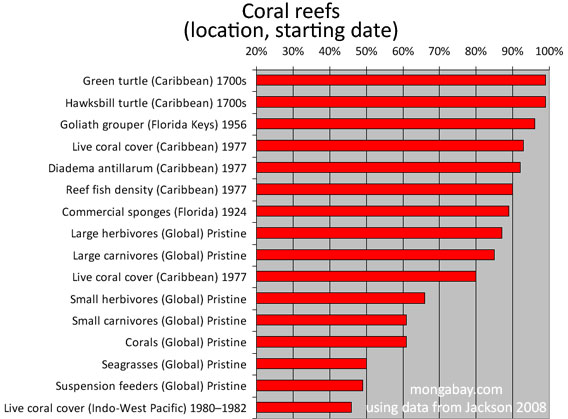
Percent decline (biomass, catch, percent cover) for fauna and flora from various marine environments. Chart based on data from Jackson 2008. |
The future ocean—and how to stop it from happening
Reviewing current trends and statistics, Jackson sees a bleak future for oceans. Overfishing will eventually create environments that are almost wholly devoid of commercial and predatory species, leaving only “small, opportunistic species”. Dead zones will continue to increase in number and size due to agricultural and industrial nutrient runoff. A warming ocean and continued greenhouse gas emissions will worsen acidification, adding more strain to the remaining reefs. Eventually, mass extinction could occur throughout the ocean’s ecosystems leading to “profound loss of animal and plant biodiversity”. Jackson adds that in this future ocean “microbes will reign supreme”.
“These predictions will undoubtedly appear extreme, but it is difficult to imagine how such changes will not come to pass without fundamental changes in human behavior,” he writes. “Moreover, as we have seen, all of these trends have actually been measured to a limited degree in the past few decades… .Some may say that it is irresponsible to make such predictions pending further detailed study to be sure of every point. However, we will never be certain about every detail, and it would be irresponsible to remain silent in the face of what we already know”.
As highlighted by Jackson, the ocean of the 21st Century is nothing like that of the early 20th Century. We have so imperiled its ecosystem, that the ocean can no longer be regarded as a reliable source of food for the future, threatening livelihoods—especially in poor nations—around the world.
“So it’s not a happy picture,” Jackson stated, “and the only way to deal with it is in segments; the only way to keep one’s sanity and try to achieve real success is to carve out sectors of the problem that can be addressed in effective terms and get on it as quickly as possible”.
 Jeremy Jackson, Scripps Professor of Oceanography. Credit: Scripps Institution of Oceanography, UC San Diego |
Jackson believes that the damage done can be undone but only with large-scale change.
“Halting and ultimately reversing these trends will require rapid and fundamental changes in fisheries, agricultural practice, and the emissions of greenhouse gases on a global scale,” he writes. “The challenges of bringing these threats under control are enormously complex and will require fundamental changes [but] very significant actions could begin right away without further scientific research or technological innovation”.
Regarding the impact of fisheries, Jackson says that the issue is not one of knowledge but rather implementation.
“The only thing standing in the way of sustainable fisheries and aquaculture is the lack of political will and the greed of special interests,” he writes, noting that many good laws and management programs are already in existence, but not enforced.
Noting an undiminished demand for seafood, Jackson writes, “wild fisheries cannot possibly sustain increasing global demand regardless of how well they are managed,” and suggests that “industrial scale aquaculture of species low on the food chain is the only viable alternative. But this in turn will require strong new regulation to prevent harmful ecosystem consequences”.
To gain control of the nutrient pollution causing eutrophication, Jackson suggests rolling back fertilizer subsidies and proposes a tax on fertilizer use. He believes such action would impose “only modest decreases in food production and increased costs”. In addition Jackson states that using less fertilizer would reduce greenhouse emissions.
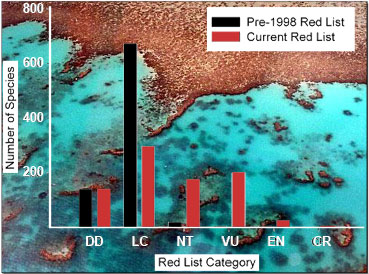
Comparison of current Red List Categories for all reef-building coral species to hypothetical Red List Categories back-cast to pre-1998. (CR=Critically Endangered, EN=Endangered, VU=Vulnerable, NT=Near Threatened, LC=Least Concern, DD=Data Deficient). |
The third and final issue Jackson addresses is climate change mitigation, stating that it is “the greatest challenge to humanity today”.
While he laments that “the problems appear so overwhelming that many are ready to write-off coral reefs and all of the other marine life that will be drastically affected,” Jackson believes that local conservation actions to protect the oceans from other threats could allow species time to develop resistance against the effects of rising CO2 levels. He notes that the atolls of the Central Pacific show relatively healthy coral populations despite climate change, probably because these reefs do not face other threats, such as over-fishing, nutrient or toxic pollution, and habitat destruction.
“Local conservation measures may help to buy time for marine ecosystems until we bring the rise of greenhouse gases under more effective control,” he says, adding that while the scale of these problems are immense, “We have to begin somewhere”.
Jeremy Jackson (2008). Ecological extinction and evolution in the brave new ocean. PNAS Online Early Edition for the week of August 11-15, 2008.



